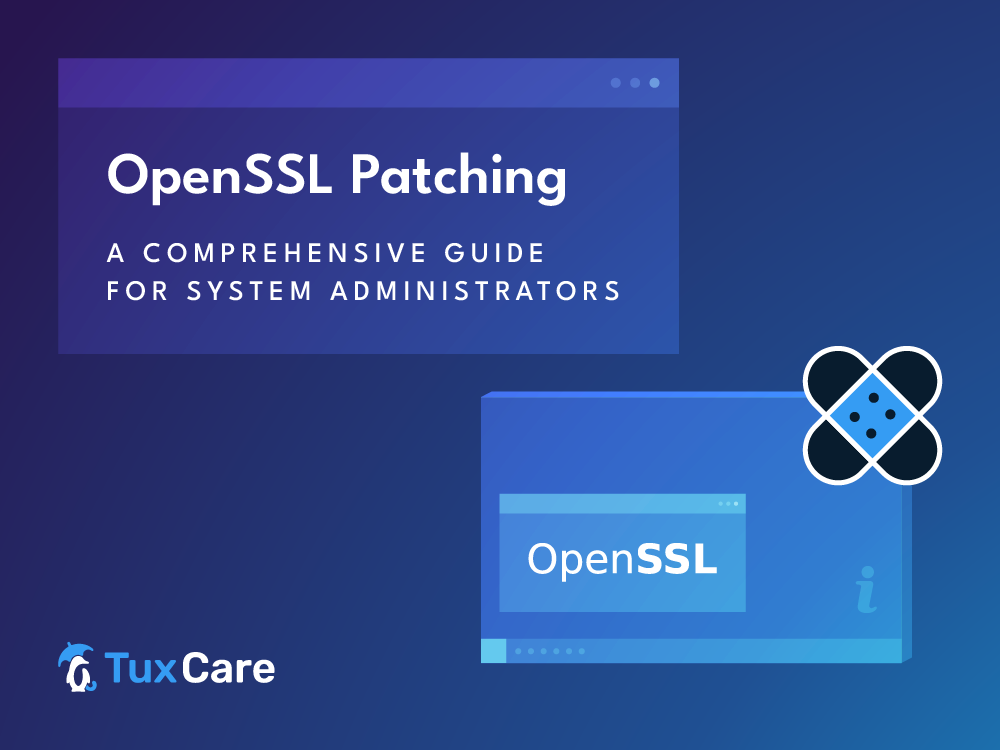OpenSSL Patching: A Comprehensive Guide for System Administrators
- Timely patching of OpenSSL vulnerabilities is essential, as attackers often exploit unpatched systems.
- Implementing automated patching tools minimizes the risk of human errors and ensures patching consistency.
- LibCare offers automated security patching for the OpenSSL library without having to reboot systems.
OpenSSL is a software library that provides an open-source implementation of SSL and TLS encryption protocols. It facilitates encryption, authentication, and data integrity, making it critical for websites, VPNs, and various other security-sensitive applications. It is often used by many server systems and the websites they host.
However, like any software, OpenSSL is susceptible to vulnerabilities, and timely patching is essential, as cyber attackers often exploit unpatched systems. The longer a system and its software go without being patched, the more likely a chance of a successful attack.
In this article, we will discuss the importance of OpenSSL patching and learn how to overcome common challenges and effectively patch OpenSSL.
Why OpenSSL Patching Matters
OpenSSL patching is the process of applying patches to the systems in order to fix known OpenSSL vulnerabilities. From the infamous Heartbleed bug to recent OpenSSL advisories, there have been many instances of vulnerabilities discovered in the OpenSSL library.
The key benefits of keeping OpenSSL up to date with latest patches include:
Mitigating Security Vulnerabilities
When new vulnerabilities are discovered, attackers find several ways to exploit the issue to gain unauthorized access to systems and critical data. Additionally, attackers can leverage vulnerabilities to crash or overload servers, disrupting critical services and causing downtime. To avoid these risks, it is essential to mitigate vulnerabilities with timely updates and patches.
Achieving Compliance Requirements
Many regulatory standards (e.g., PCI DSS, HIPAA) mandate the timely patching of known vulnerabilities, including those affecting OpenSSL. Failing or delaying to patch the vulnerability means failing to comply with these requirements, which can result in severe legal penalties and fines.
Maintaining Trust and Reputation
Security breaches resulting from unpatched OpenSSL vulnerabilities can harm your company’s reputation and undermine client trust. Proactive patching demonstrates a commitment to security and helps maintain a good reputation.
Common Challenges and Solutions
While the importance of patching is undeniable, system administrators often face challenges during OpenSSL patching.
Compatibility Issues
Patching may introduce compatibility issues with existing applications or configurations. Thus, it is essential to test patches thoroughly in a staging environment before deploying them in a production environment. Some issues can be addressed by updating dependent packages or libraries as needed.
Downtime
The conventional patching method often requires a system reboot, causing service interruptions and potentially disrupting user experience. LibCare from TuxCare offers automated security patching for OpenSSL without having to reboot systems, ensuring 100% service availability. LibCare is available as an add-on tool to KernelCare Enterprise (automated live patching tool for Linux distributions). With KernelCare and LibCare together, enterprises can ensure the maximum protection of their Linux ecosystems.
Learn more about live patching for Linux.
Risk of Patching Errors
The conventional manual patching process often involves the risk of human error, leading to misconfigurations or incomplete patch deployments. Implementing automation tools minimizes the risk of errors and ensures patching consistency across entire infrastructures. Regularly auditing patching activities helps identify and remediate any discrepancies or deficiencies.
Navigating the OpenSSL Patching Process
To effectively manage patching processes, system administrators should follow these best practices:
Stay Informed: Follow security news and advisories from the OpenSSL project and other trusted sources to stay aware of new vulnerabilities and patches.
Prioritize Patches: Evaluate the severity and impact of each OpenSSL vulnerability and prioritize patching based on risk assessment. This includes first addressing critical vulnerabilities that pose a higher risk to your infrastructure. Also, it is essential to determine if the vulnerability affects your specific deployment or configuration.
Plan Patching Strategy: Create a patching schedule that balances the need for timely updates with the requirement for thorough testing to minimize disruptions. Remember, you can utilize LibCare’s live patching solution to eliminate patching-related downtime.
Test Patches: Always consider deploying patches in a non-production environment to identify any compatibility issues and ensure they work properly with your existing applications and services.
Automation Tools: Utilize automated solutions like LibCare to streamline the OpenSSL patching process with minimal human interaction or errors.
Rollback Procedures: Establish rollback plans in case unexpected issues or failures arise during the patching process. Document the steps required to revert to the previous version of OpenSSL to minimize downtime.
Final Thoughts
By following these best practices and addressing common challenges, system administrators can effectively manage OpenSSL patching ensuring the security and integrity of their critical systems and data. Any delay in applying a new patch to fix a vulnerability could leave the door wide open to a successful attack. Therefore, stay vigilant, stay informed, and prioritize security to protect your organization from potential vulnerabilities and breaches.
Send any patching-related question you have to a TuxCare security expert to learn about modernizing patching for your Linux ecosystems.



 Documentation
Documentation Login
Login




